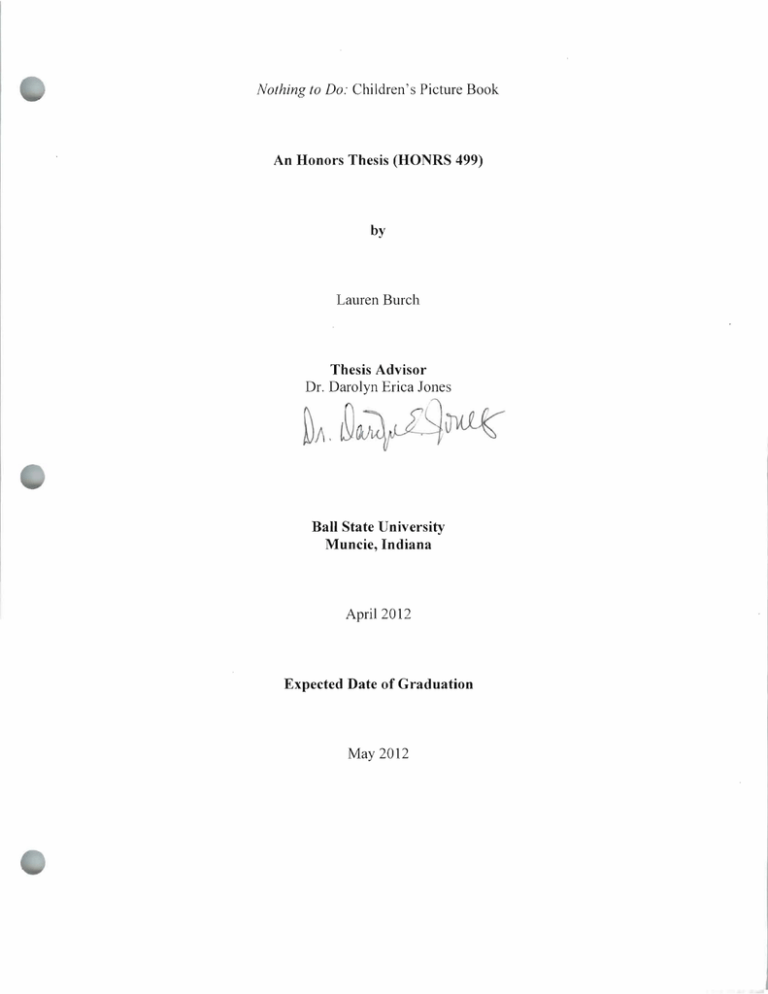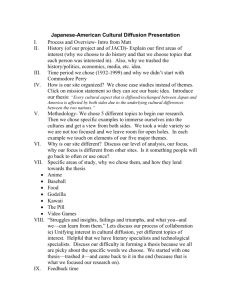D~.~~~
advertisement

Nothing to Do: Children's Picture Book An Honors Thesis (HONRS 499) by Lauren Burch Thesis Advisor Dr. Darolyn Erica Jones D~.~~~ Ball State University Muncie, Indiana April 2012 Expected Date of Graduation May 2012 SpC'oll LAndercf .£~ 1/te5iS L-D ~1 Abstract 9 Z4 2DI' .B86 Although I have studied picture books from a literary standpoint during my time at Ball State University, picture books have never been an area of study in my writing courses. For my creative thesis project, I chose to educate myself on the specific skills and techniques utilized in picture books, and to write and illustrate such a book of my own. I studied the current market and reception of children's books and enrolled in ENG 204, Children's Literature, to prepare myself for the project. Acknowledgements I would like to thank Dr. Darolyn Jones for advising me through this project, and for allowing me a place in her Children's Literature class this semester. The final product would not have been possible without the insight, advice, and encouragement she provided throughout the semester. I would like to thank Ryn Bailey, fellow creative writing student and close friend, for instructing me through the use of Adobe InDesign. Without her technological wizardry, this book would never have conle to fruition. I would like to thank Ball State Printing Services for their patience and assistance in printing this project. I would like to thank Colton for encouraging me throughout the semester and for providing a never-ending source of inspiration. I would like to thank my mother for providing me with a lifelong love of books and for pointing me in the right direction in regards to my research. Author's Statement Picture books have always captivated me, even after I developed the skills as a reader to progress onto novels. It is not easy to tell a story as compelling and engaging as the greatest novel; it is still harder to tell as story with far fewer words and with illustrations added into the creative process. Through my years at Ball State as a creative writing student, I have honed technical skills such as clear, concise language and developing tight and quick plots for short stories. Believing that these abilities would be of use in the construction of an effective picture book, I chose to illustrate, write, and print a book for my creative thesis project. To educate myself further on picture books and their audience, I enrolled in ENG 204, Children's Literature, taught by my thesis advisor, Dr. Darolyn Jones. In class discussion as well as the assigned readings, we discussed the elements of a well-written children's book, such as precise and appropriate vocabulary for the intended audience, believable dialogue, and figurative and flowing language (Tunnell et aI., 17-26). We also discussed the defining traits of a well­ illustrated picture book, including the use of illustrations to reinforce the text, show a situation from multiple points of view, establish setting and mood, and further develop a story's plot (Tunnell et aI., 29-33). Throughout the semester, I completed projects such as analyses of the genres of children's literature or the traits of specific authors, furthering my understanding of the components that went into a picture book. I also wrote and presented a book talk during the class, identifying and articulating what made a picture book appealing to me and worth recommending to others. To better understand the current world of children's literature, I also researched the market for picture books. I purchased a copy of the 2012 Children's Writer's & Illustrator's Market and began reading the children's book sections of the literary journals Publishers Weekly and Kirkus Review. I found that while children's books sales have remained relatively stable during the recession (Publishers Weekly, 2012), the market for digital picture books are on the rise (Sambuchino, 85). I had been considering making a book with pop-ups or textured illustrations, but after my market research I chose instead to make a book which could be scanned and read in a digital format without losing the essence of the pictures. I also discovered that paperback books are currently selling better than hardback (Sambuchino, 89) and that fantasy stories are growing more popular (Tunnell et aI., 53), both of which influenced the decisions I made regarding the paperback format and plot content of my own picture book. I examined Publishers Weekly's article, "Best Children's Books of2011," to see what, if anything, the selected books had in common and what I could emulate from those works. Among the selected was Jon Klassen's debut book I Want My Hat Back, which I was already familiar with due to the book's popularity on the social media website Tumblr (Publishers Weekly, 2011). Upon seeing the recognition that one of my favorite recent picture books had received, I decide to style my picture book in the same manner as I Want My Hat Back, using simple, repetitive imagery and making my story a "pattern" picture book, i.e., a book that repeats scenarios and phrases throughout the story (Tunnell et aI., 67). In I Want My Hat Back, a bear asks animal after animal if they have seen his n1issing hat, and replies "Okay. Thank you anyway," when met with the inevitable "no." In my own picture book, Nothing to Do, a girl and her cat wander from room to roon1 of her house in search of an adventure. Each room is dismissed as lacking, and each scene ends with a "meow" from the cat. I chose to write my book in rhyme partly as homage to my favorite children's author, Theodore Seuss Geisel, and partly because poetry was never a focus of my creative writing studies and I wanted to further challenge myself on the project. My decision to write a young girl as the story's protagonist was cenlented after I looked through my collection of Dr. Seuss' s books and realized that only one of them, Daisy Head Maisy, featured a female lead. I created the illustrations via collage, using paper, felt, and yarn, because I felt that it would be easier to maintain consistency from page to page if I were cutting paper rather than attempting to draw the same faces and bodies multiple times. I also felt that the texture of the paper and the yam, visible on the scanned and printed pages of the book, made the simplistic illustrations more engaging to look at. Apart from the book's final page, the story only utilizes three colors: black, white, and red. I chose this restricted palette to underscore the boredom experienced by the protagonist in her search to find sonlething to do. I printed and stapled the book together on my own partially due to time constraints and partially because I had planned at first to bind the original pages together by hand and submit the handmade book for my thesis. However, I eventually chose to scan the pages and submit a printed copy to the Honors College, as I wanted to keep the original book for myself. Works Cited Sambuchino, Chuck. 2012 Children 's Writer's and Illustrator 's Market. Cincinnati : Writer's Digest Books, 2011. Print. Tunnell , Michael 0., James S. Jacobs, Terrell A. Young, and Gregory Bryan. Children's Literature, Briefly: Fifth Edition. Boston: Pearson Education, 2012. Print. Unknown. "Best Children ' s Books 0[2011. " Publishers Weekly. 4 Nov. 2011. Online. < http://www.publishersweekly.comJpw/by-topic/childrens/childrens-industry­ news/article/49395-pw-best-books-20 11-children-s-books.htn11> Retrieved 23 Jan. 2012. Unknown. "Spring 2012 Children's Announcements." Publishers Weekly. 17 Feb. 2012. Online. <http://www.publishersweekly.com/pw/by-topic/new-titles/childrens­ announcementslarticl e/5 0691-spring -2012 -children -s-announcements .html> Retrieved 23 Feb. 2012. CIS' ~ -­ Nothing To Do Lauren Burch Honors Thesis Creative Project Spring 2012 Acknowledgements To Darolyn Jones, whose great advice and encouragement was exactly what I needed to stay on track throughout the semester. To Ryn Bailey, whose apparent wizardry with InDesign made this book possible. And to my mother, who instilled in me a life-long passion for books and storytelling in its many forms. Igo crazy if l'tM stuck here all day! there's t10 ot1e to talk to, at1d t10 otle to play! at to do?» she asked, tMovit1g Robert fro~ her glass. losit1g tlty tltit1d here! We have to thittk fast!» She slut1k across her bed roo", at1d it1to the hall. "I'd rather walk arout1d the house that1 do t1othit1g at all. ill l hiiaWleii~iaiua!d l~ have to thit1k of how.» Robert fit1ished up the ",Uk at1d followed with a stMali "",eo ~ air a slMeli of dirty socks hUt1Q about oor covered it1 posters at1d sigt1s tMarked "KEEP our," t1gela thought of ktlockit1g to at1t1oy her brother, t they'd had".fil~t'tl&day; she didt1't watlt at1other. +.. . ,,~ c..c.l"e.o.. \ The washer spun clothes as the dryer shook and roared; There wasn"t tHuch in the laundry rOOtH and At1gela ( . , Robert hopped ittto the basket curlit1g She looked behittd the dryer but f were chetHicals in the closet she wast1"t al could ride a brootH or play With rags, but b The wallpaper was peeling, with sotHe It was'tgpife~:e\such spot was shauLu •• on the floor by at1 old box of soap flakes. ewasher until her stoIMach ached. at they had better leave now; swered with a, "tHeow:' down the stairs; hairs the cellar; "The Jasel\tent ~weller.'" Angela ran to the bathroot11 to hide in the tUb, Stopping short as she watched her sister scrub Her hair i., the bubble bath with creat11 her Cucut11ber slices on her eyes, headphones in pi 0" Aplace ~lIed with water wasn't tMuch good for At least, not a place that a cat was abiding. fhe thing frot11 the baset11ent hadn't followed t Robert shrank frot11 the water; fur standit1g 0., ot\t;' she said, stepping out. er way, she had "0 doubt. pour Robert cat chow; re with a ttteow. ••_."1 • .. •. ••••• . ----­..... •••••••••• .•••••••• ••••••••• ••••••••••••••••••••• ~ ~ ~ - - - - !



